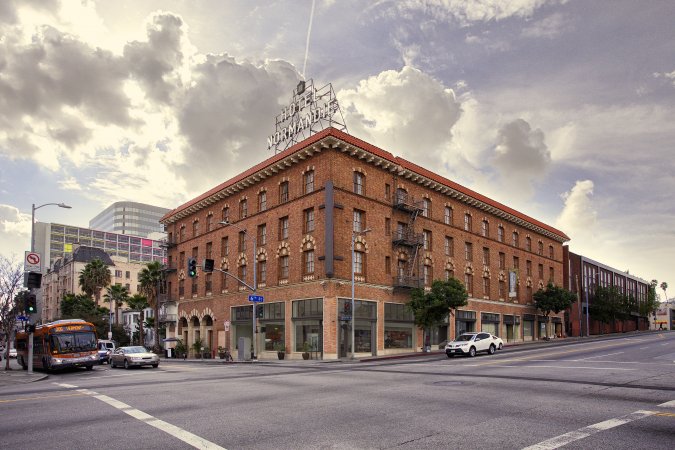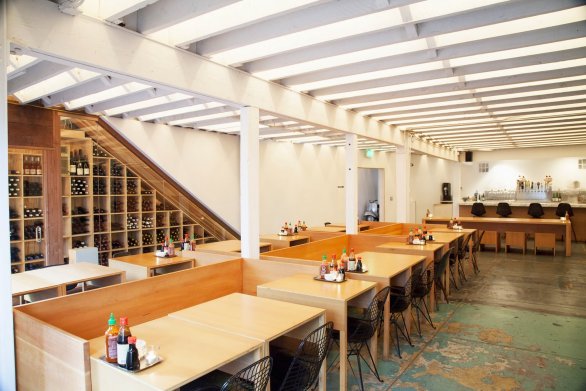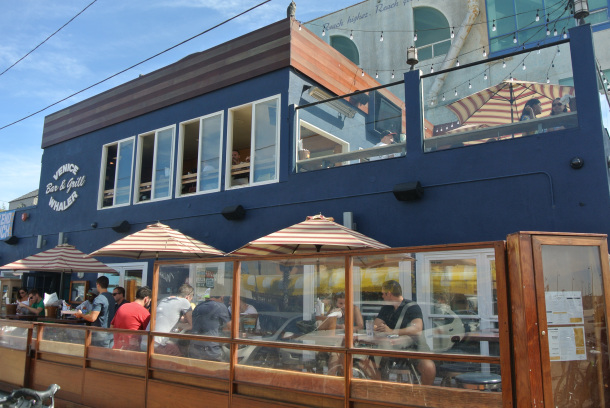May

May 18, 2018
Hotel Normandie’s Update
Hotel Normandie was built by famed Los Angeles architects Albert R. Walker and Percy A. Eisen in 1926, falling into a state of disrepair between its original incarnation and the 21st century. That is, until architect and preservationist Jingbo Lou gave the historic building a much needed update in 2010. FE signed on for the ambitious project, working for the next four years on the property’s various spaces.
We started with remodeling and updating the hotel service kitchen that supplies the entire building, including room service to hotel guests. The hardest component of this part of the project was orchestrating the limitation of occupants for the entire building. We had to negotiate a compromise with Building and Safety to allow the increase of the several uses now present, like having a separate service kitchen, two restaurants, and a bar all in the same building.
Next, we worked extensively to relocate and restore Cassell’s Hamburgers, a neighborhood staple since 1948. As an all-day eatery with a restaurant, bakery, coffee and bar, there were many uses to consider when moving the space. FE crafted the kitchen design and layout for the multi-purpose restaurant and secured ABC licensing, entitlements, and health permits for the space.
In addition to Cassell’s, Le Comptoir and The Normandie Club occupy Hotel Normandie’s grounds and also needed ABC licensing, entitlements, and health permits. On top of these services, for The Normandie Club speakeasy we assisted in bar equipment design.
All in all, working with Hotel Normandie as a historic landmark made the process of obtaining entitlements, ABC licensing, and health permits much more challenging. Although a long process, it was certainly a rewarding one. Hotel Normandie stands as a reminder of another era in Los Angeles, one that continues to serve visitors and locals alike. And even though we completed the hotel’s multiple spaces back in 2014, our relationship didn’t end — we continue to be the main health department consultant whenever trouble arises and remain friends with owner and architect Jingbo.
April

April 18, 2018
On the Ball with Teragram Ballroom
The theater the Teragram Ballroom inhabits has been active since 1913, but it wasn’t until recently that its use as an arts space was re-established. Under the direction of brother duo Brian and Michael Swier, the Teragram Ballroom saw a return to its theatrical roots and its conversion into a live entertainment space complete with an on-site bar and restaurant. The Swiers reached out to FE Design to coordinate alcohol licensing, health and building permits, and expediting services for the century-old building.
Since the building had most recently operated as a print shop, FE filed for a change of use permit to allow for the sale and dispensing of a full line of alcoholic beverages, live entertainment and patron dancing, a theater and restaurant, and alterations to the facade. As the space had once been a theater and the domed ceiling, original lobby area, and intact stage were still prominently featured in the building, the previously existing use was revitalized.
The most challenging aspect of the project was procuring community support for Teragram Ballroom as other nearby bars and establishments set a poor precedent for respecting neighboring locals. With an interest in appeasing community concerns, FE set out to construct substantive plans that would protect the neighborhood and assuage any complaints.
We highlighted the rehabilitated property’s positive influence on crime rates at community meetings and outreach efforts where we also detailed the lengths at which the Teragram team was willing to go to keep the space neighborhood-friendly. This included extensive plans for security guards and camera, queuing lines, patron access, and parking arrangements. An acoustical engineer was even hired to retrofit the property and ensure that noise and vibrations emanating from the venue would not adversely affect the surrounding properties.
We wrapped up the project with health and building permits, kitchen design for the on-site diner converted into a sit-down restaurant, and resolving an industrial waste violation. Through amassing widespread community support and re-establishing a historic venue, FE Design ensured that the Teragram Ballroom can continue its place as a leader in the Downtown area.
Photo courtesy of USA Today.
March

March 18, 2018
Blossoming kitchen design
Blossom’s location in Silver Lake may be known for its classic Vietnamese food, amazing wine program, and two-tiered dining, but the process of legalizing all of the above wasn’t exactly easy. FE signed onto the project to provide kitchen design and alcohol licensing for the restaurant’s second location.
In terms of kitchen design, FE took the layout provided by the architect and converted it into detailed kitchen schematics that fit into initial concept drawings for both the ground floor and the subterranean level. This entailed finding the necessary kitchen equipment and knowing how logistics, operations, and code compliance would work together cohesively in the space. Additionally, we ensured everything in the back of house was code compliant and up to department standards while also providing plans for the rest of the project.
The opening of this location of Blossom, however, proved to be more difficult than just kitchen design. The restaurant had to obtain a Conditional Use Permit to allow for the sale of beer and wine since the previous tenants had not sold alcohol. This process required collecting community support, attending public hearings regarding the change, and passing amendments through the Silver Lake City Council. We were proud to stand next to our client through the entirety of the process, serving as Blossom’s public representative and spokesperson as we convinced hesitant locals of the value of adding the restaurant to the neighborhood and the positive track record of its owner, Duc Pham.
Additional requirements for opening the restaurants including securing an additional 15 parking spots, facilitating an official Geological Report to allow subterranean dining, and passing a hardship claim that altered the compliance of the ADA restroom due to the disproportionate cost. Now, the restaurant is busy revitalizing the Sunset Junction area with its authentic Vietnamese food, astounding wine program, and underground speakeasy feel.
Photo courtesy of Blossom.
February

February 18, 2018
Our History with N/Naka
Chef Niki Nakayama has been a major force on the LA dining scene, especially since opening her restaurant n/naka in 2011. Our partnership first started in 2010, long before the restaurant received its critical acclaim, Chef’s Table feature, or months-long waiting lists. We helped Niki secure the proper permits to ensure that she could serve a modern kaiseki dining experience with no obstacles.
A little background on n/naka: diners enjoy a 13-course culinary experience that relies on the freshest seasonal ingredients–some of which comes from Niki’s own home garden–and presents them in their most natural state with an artful perspective. No guest ever experiences the same dish twice, meaning Niki takes the time to record every dish a customer is presented and guarantees that their next visit will be complete with an entirely new menu. N/naka continues to collect local and national acclaim, frequently gracing ‘Best of LA’ lists.
With all that Niki aspired to do at n/naka, we took care of all of the technicalities of opening a new restaurant. That meant obtaining a Conditional Use Permit to allow for the sale and dispensing of beer and wine, securing a Zone Variance to allow for leasing parking off-site, and serving as the representative at local council and committee meetings. We navigated police conditions, health and building codes, and plumbing and kitchen requirements to acquire these permits. Most importantly, we permitted the property to change its use from office spaces to a sit-down restaurant so it could open its doors.
When the permits were set to expire in 2014, Niki called us once again to handle the process. FE provided the renewal of all permits and entitlements so the restaurant could continue operating. Bottom line, we love working with Niki and the n/naka team. She understands and appreciates the work that FE provides for our clients and nothing makes us happier than seeing her continued success.
Photo courtesy of Darin Dines.
January

January 18, 2018
The Venice Whale of a Tale
Since opening in 1944, The Venice Whaler has been a community anchor in Venice Beach, providing food and drinks to locals and tourists and even the likes of The Beach Boys, The Beatles, and The Doors. When ownership changed back in 2014, restaurateur Mike Dobson called FE Design to help update the historic property.
The Whaler’s long history in Venice gave it certain advantages and disadvantages which FE researched extensively and took into consideration while working on the project. What started as an effort to legalize a portion of the outdoor patio to serve alcohol morphed into a more complicated issue.
Due to its age, The Whaler was entitled to certain grandfathered rights that protected it from new regulations. Among these, the property held exceptions to alcohol licensing and required parking as it predated regulations in these two areas. However, these grandfathered rights did not extend to additions to the permitted square footage, such as the patio and take-out window awaiting approval.
The main issue was that the patio had existed and operated under the previous owner, but it was never fully permitted. The new owner, Mike, sought to legally permit the entire patio with alcohol licensing, as well as the take-out window. As this technically fell under new space for the property, the outside space was subject to modern parking regulations. Since The Whaler is located in a busy coastal zone, the bar is also subject to intensified parking requirements, meaning that just adding a patio and take-out window resulted in the demand for 28 new parking spots.
These parking requirements were impossible to fulfill given the already crowded quarters of Venice Beach. Instead, FE worked tirelessly to find viable parking alternatives — from a public valet to renting out a local school’s parking lot to offering discounts to customers utilizing public transportation and ridesharing. This transportation and management parking plan resulted in The Whaler’s fully-permitted and alcohol-serving patio, which 50% of customers request to be seated at.
One of the key components of The Whaler’s success over the years was its widespread community support, so to keep noise down for the locals we permitted state-of-the-art sound dampening awnings. Our last contribution to The Whaler was securing health and building permits so the historic establishment could continue serving its loyal fans. The Whaler is still catering to its beachside community, just as it has for the past 70 years — but now, the bar and grill can legally serve its patrons in its outside spaces (which boast a view of the Pacific).
Photo courtesy of NaokoEats.
